Lately this photo has been popping up on various social media, reminding me that a long time ago, before this improbably named site began, I did a little digging into the stories behind the photograph on my personal blog, and I thought it was time to take another look.
First, a little background. This isn’t a cute picture of cute newsboys out selling papers before breaking into a musical dance number, and it drives me mad that it keeps popping up stripped of all identification and context, deliberately robbed of meaningful information. This is a photograph taken by Lewis Wickes Hine, one of many in a series intentionally aimed at bringing the injustices of child labor to light, highlighting the children that our society was utterly failing – children who were orphaned, abandoned, under-supported and left to their own devices.
Each one of the boys in this picture was the son of immigrants. Each one saw trouble with the law, starting right around when this was taken. For some, that trouble continued their entire lives.
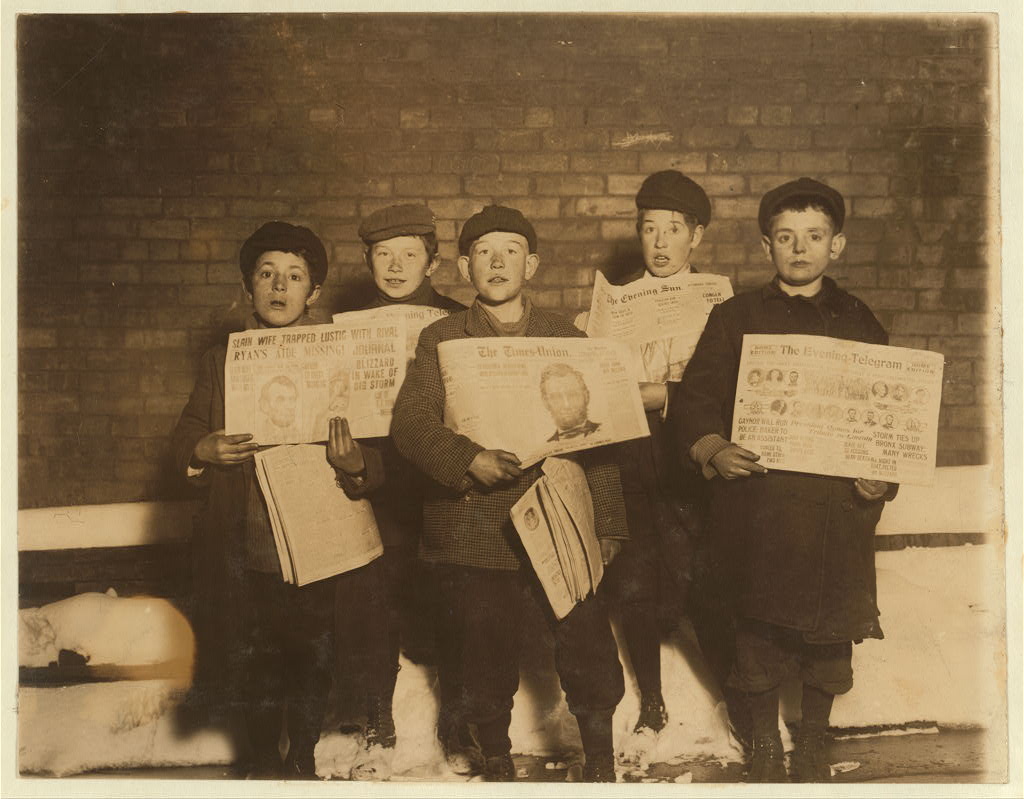
This photo by celebrated photographer Lewis Wickes Hine, posted by the Library of Congress, shows a group of newsboys who were selling evening papers in saloons and stores. It was taken “in an alley in back of the City Jail at 10 P.M” in February , 1910. Many of the Hine photographs lack identification of the subjects, but for this one, we are gifted with full identification. The newsboys are identified as, left to right: Dominick Mardilo, 28 1/2 Fulton Street; Roderick Towle, 44 Sheridan Ave.; William Towle, brother, 44 Sheridan Ave.; Louis Strasburg, 40 Mulberry Street; Max Erlich, 101 Dallius Street.
Lewis Wickes Hine was a sociology professor who used photography as a tool for reform; this picture and many others that preserve bits of Capital District and national history were taken for the National Child Labor Committee. Hine’s work was some of the earliest documentary photography and helped bring about child labor laws. But he also preserved images of people and places that would otherwise never have been documented.
What became of these newsies? I wrote about them 14 years ago with considerably fewer resources available. Now, while there are still questions and incomplete information, the records that have become available in that time can help me tell a fuller story of these lives. So here they are.
Dominic Nardolillo
Our first newsboy, Dominic, presents some challenges. Those started with Hine getting his name wrong: It’s Nardolillo, at least on some official papers. In the newspapers, it’s sometimes Nardillo, Nardello, or Nardella. Dominic ends with a ‘c’, except when it ends with a ‘k’. And to add to confusion, while this Dominic, son of Francesco and Mary Nardolillo of 28 Fulton Street, was born in 1898 in New York state, over on Dallius Street there was another Dominic Nardolillo, son of Giovanni (or John) and Mary, who was born in 1896 in Italy. Add to that: the newspapers of the day either weren’t super diligent about the names and ages of the boys they were reporting on, or the boys (gasp) regularly lied about their ages for one reason or another. That makes it very, very hard to sort out what happened to which Dominic.
Both were from large, working class families, when there was work to be had. Fulton Street Dominic, our newsboy, was the second oldest of nine children; Dallius Street Dominic was the second oldest of seven (at least, in 1910). They lived within a few blocks of each other. Did I mention they both had J as a middle initial? So it’s possible some of these events happened to the other Dominic – his family definitely found its way into the newspapers – but for the most part I think these were the doings of Dominic the newsboy.
Father Francesco came to the US from Italy in 1895 and had been naturalized by 1910. Mother Mary came from Italy the following year. Their children were nearly all born here, and in 1910 they were all living at 28 Fulton Street, on the east side, between Madison and Van Zandt. It’s a parking lot today and has been for a very long time. Giovanni (John) Nardolillo lived right nearby, and was likely a brother.
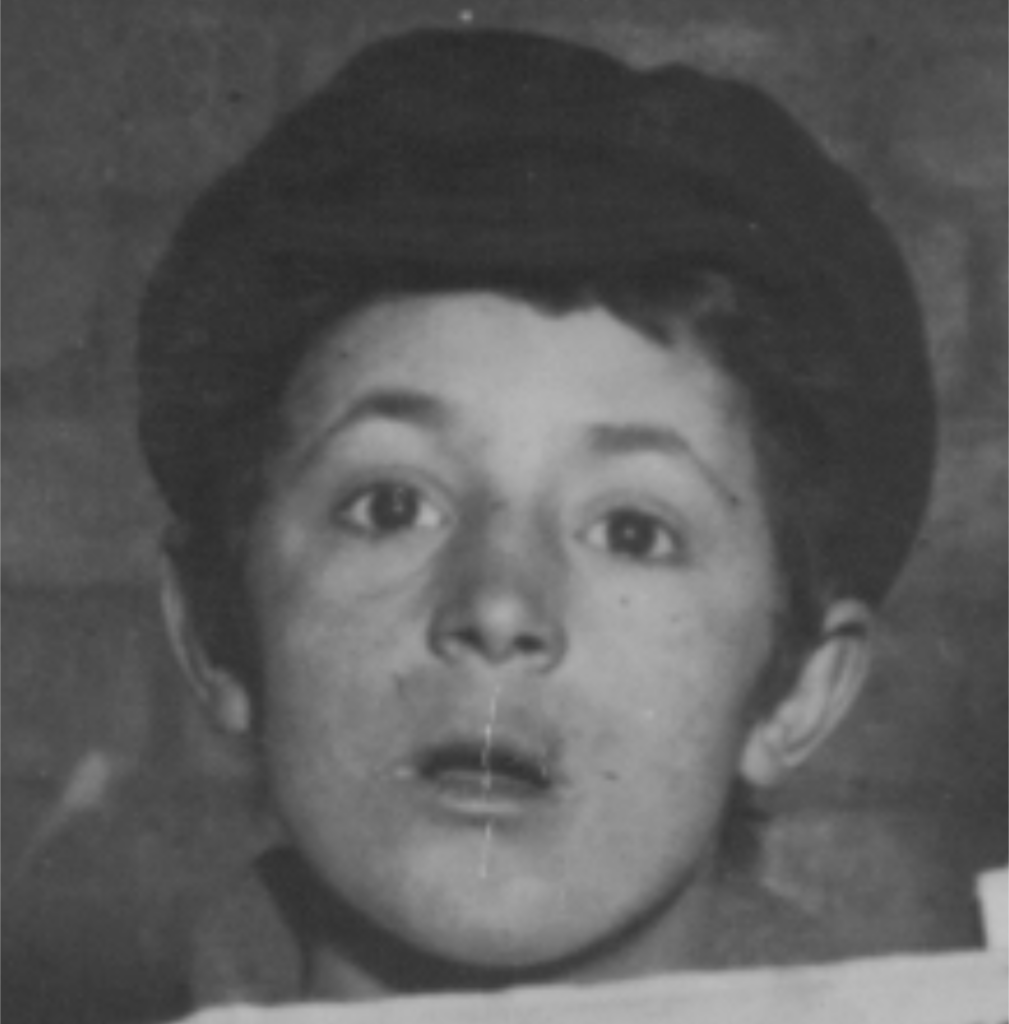
Dominic’s adolescent years were marked by frequent run-ins with police, appearances before a certain Judge Brady, and periods of commitment to the Humane Society and St. Vincent’s Male Orphan Asylum, which was a place the system placed not only orphans but boys who had been abandoned or whose families couldn’t support them, at least for short periods of time. In 1908, he was charged with being a “disorderly boy” and sent to St. Vincent’s. In 1910, still on probation for something, he was charged with selling papers on the street at 12:15 a.m., a violation of city ordinance. Later that year, he was arrested for “lounging” and had items in his possession alleged to have been stolen from one of the ten-cent stores on North Pearl Street.
In June 1911, age 13, he was one of four boys arrested for shooting craps; one of the other newsboys from the Hine photograph was arrested as well. It should be no surprise, since Hine actually photographed them doing exactly this in 1910 (scroll down for the photo).
“Dominick Nardillo, Charles Hetta, Harry Abrells and Max Erlich, boy crap shooters, who were interrupted in a game at the foot of Columbia street by Detectives Buchanan and Andres, who confiscated the pot amounting to 48 cents, were before Judge Brady yesterday in juvenile court. The quartet was committed to the care of the Humane society until Saturday. Hetta and Nardillo have been arrested several times on similar charges.”
The outcomes of these cases often didn’t make the news, so it’s not clear what happened next, but sometime that July, Dominic appears to have disappeared from home for a couple of months, showing back up in September, at which time his mother went to the court for help.
An article in the Sept. 19, 1911 Evening Journal was headlined: “Dominick Nardillo the Incorrigible – Arraigned in Juvenile Court This Time on Complaint of His Mother – May Be Sent to Industry.”
“Dominick Nardillo, one of the most incorrigible boys ever arraigned in Juvenile Court, and at the same time one of the brightest, is again in the Human society building, and is likely to be sent to the reformatory at Industry [south of Rochester]. He is 13 years old, and bobbed up in Judge Brady’s Boys’ Court some years ago. He has been a steady attendant ever since.
“Sometimes he would be charged with snatching baggage from tourists at the Union station and steamboat landings, and then he would be accused of staying out all night, and sleeping in the vestibules of hotels and under stoops. Each time, however, he had a ready tale for the magistrate, and for a time his parents stood by him and tried to shield him. Then all of a sudden they became convinced that Judge Brady’s talks to the boy were right, and some weeks ago Mrs. Nardillo came to court and swore out a warrant, saying the boy had been missing since July 15[?].
“His mother charged him with being a disorderly boy, and the police made every effort to land him, but without avail. Last night Dominick showed up, and was promptly turned over to Court Officer McGrant, although as usual he begged for another chance.
“This morning Judge Brady asked him where he had been all summer, and he replied that he and a number of his companions had been camping down at Van Wie’s Point. The magistrate sent him to the Humane society, and in the meanwhile is thinking hard what to do with the youngster.”
He seems to have disappeared from the news for a year, but in September 1912, he was found under the headline “Boy Arrested Again.”
“Domonic [sic] Nardillo, a boy, who according to the police, has many times been in the hands of the police, was arrested by Policeman Cain on the charge of stealing a bottle of wine at the store of the W.E. Drislane Co. on North Pearl street. Nardillo was committed to the Humane society shelter to await examination in Juvenile Court this morning.”
1915’s newspaper articles are where it gets a little less clear which Dominic was the subject. In summer 1915, Dominic the newsboy should have been 17, but two news reports gave ages of 18 and 19 – making it possible these incidents involved the other Dominic from Dallius Street. One Dominic or the other was charged on suspicion of larceny for being unable to explain where he got 58 boxes of cigarettes which he was “trying to sell to an Italian who runs a fruit stand at the corner of South Pearl and Hamilton streets.” He said he’d bought them from a hobo. That same summer, he was locked up for a fight in a pool room, and in November was on the scene when a gang dispute led to a stabbing across from Union Station. But it’s not possible to tell if any of these were Dominic the newsboy’s crimes.
In 1920, Dominic Nardillo was a member of a swimming party, two men and two women, in the Normanskill at Normansville from which Leola Sans Souci, 21, did not return. “The Sans Souci girl was the first to step off the spring board and attempt to swim across the creek. When in the middle, she suddenly sank and failed to come up.” The Argus reported that she was “seized with cramps.” I suspect but have no proof this is our Dominic the newsboy, though newsboy no longer of course – in 1918, he was a laborer for his neighbor, Frank Leone, and in the 1920 census, he is listed as a salesman for a department store. At that point the census was recording the family as “Nardillo” or perhaps “Nardilla” (thanks, cursive!). He was living at 28-1/2 Fulton Street; his father was listed as 28 Fulton Street, with no wife listed but six daughters (the youngest aged 9) and one son.
We get to 1925, and I really wish I knew for sure which Dominic was involved because it would give us a sense of what he was doing to support himself. Well, it would if the newspapers had had any interest in explaining exactly what was going on. “Three armed men held up a group of men in a room on the second floor at 43 Beaver street at 11:30 last night and fled with cash and jewelry valued at $11,000,” the Knickerbocker Press reported on Jan. 23. Dominick Nardillo, “who was in charge of the room at the time,” said he lost $2,780 in the robbery. “The proprietors are known as Dominick ‘Barge’ Nardillo and John ‘Scotch’ Morrissey” – though what they were proprietors of, the newspapers never chose to reveal. The name “Barge Nardella” shows up again in the early 1930s, as a prominent local bowler. I have a suspicion that there was gambling involved – and if that’s the case, then perhaps this is the same “Dominick Nardella” who started showing up in the news around 1935 as a champion pinochle player. While the newspapers said he lived at 276 Second Street then, his age was never given.
After that, there are just some other random mentions, including a heroin charge in 1939, but again, I can’t definitively say which Dominic it was. It may have been the Dallius Street Dominic, who had gotten himself severely stabbed in 1930. Inconveniently, both disappear from the city directories at times, and often in the same years – I suspect at least that Dominic the newsboy was living under his father’s roof on Fulton Street a lot of that time and thus not listed on his own. When he was listed, our Dominic worked as a taxi driver or a salesman.
On Feb. 27, 1953, the Knickerbocker News was running what I think today would be an unimaginable contest – they would print a photograph of license plates they saw around the city, and if a reader recognized their license plate, they would win a $25 prize. “Dominick Nardolillo, 63 Grand St., whose lucky license number 1F 38-57, appeared in The Knickerbocker News Monday, said today the insurance on his 1936 model car is due and the award ‘will help pay it.’ Mr. Nardolillo, who is employed as a custodian at the Albany Center Market, said some of his fellow workers first noticed his license number in the newspaper. ‘I didn’t believe it,’ he said. ‘I’ve never won anything before in my life. I had to look at the paper myself to make sure no one was kidding me.’ He said the license plate on his car must have been photographed while it was parked in the market. ‘It’s there every day,’ he said, ‘and Saturday I saw a photographer there, but I didn’t think he would take a picture of my car.’”
And his picture ran with that article. Could it be the same newsboy, 43 years later?
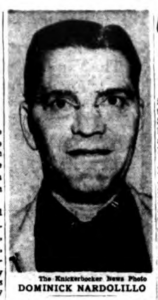
I find no information on the end of Dominic’s life.
The Towle Brothers
I would not have thought the second and third boys from the left in this picture could be 13 and 15, but it does appear that Roderick was born in 1896, and William in 1894. The Towles living at 44 Sheridan were the family of John J. Towle (born c. 1865 in England to Irish parents) and his wife, Mary Fleming Towle (born in the US in 1871, or 1874, or 1878, depending on the source; her obituary would indicate 1874). When this picture was taken in 1910, John was serving time in the Albany County Penitentiary. He (born c. 1865) reported he had immigrated from England in 1880. His occupation was fireman (probably the railroad kind), and he also reported that at age 45, he had been married 28 years, but given Mary’s age that has to be an error; 18 years seems more likely, and is much closer to the year of William’s birth.
In 1911, John got 60 days for stealing a gold rosary. In 1912, he was arrested for vagrancy in Cohoes, where he was wearing a fake bandage to solicit sympathy, and got six months. In 1914, John Towle was sentenced again to another year in the penitentiary – this time for theft of a watch and chain valued at $20 (or $25, depending on the newspaper) from a carpenter. The Argus reported that “John Towle, who, the police assert, has many times before been in the clutches of the law for failing to provide for his family and also for petty cases of thievery, bobbed up again yesterday before Judge Brady on a petit larceny charge.” The Times-Union said he had only been out of the penitentiary for a month, and had three prior convictions for larceny. As for failure to provide, he reported he had given his wife “$2 two weeks ago, and nothing since.” It would appear that he got arrested and confined frequently, and perhaps preferred lodging at the penitentiary.
In 1926, John and Mary are listed as living at 77 Orange St., and Roderick is a laborer who lives at 80 Sheridan. William is not listed in Albany that year. I haven’t found information on John’s death, but in 1954, Mary is living at 300 Second Ave., listed as John’s widow. Roderick lives there as well, listed as a chauffeur with the Albany City Bureau of Sanitation.
William Towle
William had an active youth, at least by accounts in the newspapers. His ages are given so variously as to be unreliable, but I’m fairly certain the mentions below are all of the same young man. Given his father’s nature, it is perhaps not surprising that William was scrambling around, doing whatever it took to survive, and that at one point he reported that his mother was dependent on him. It’s also not surprising that he learned the trick of begging with a bandage on to look more pathetic.
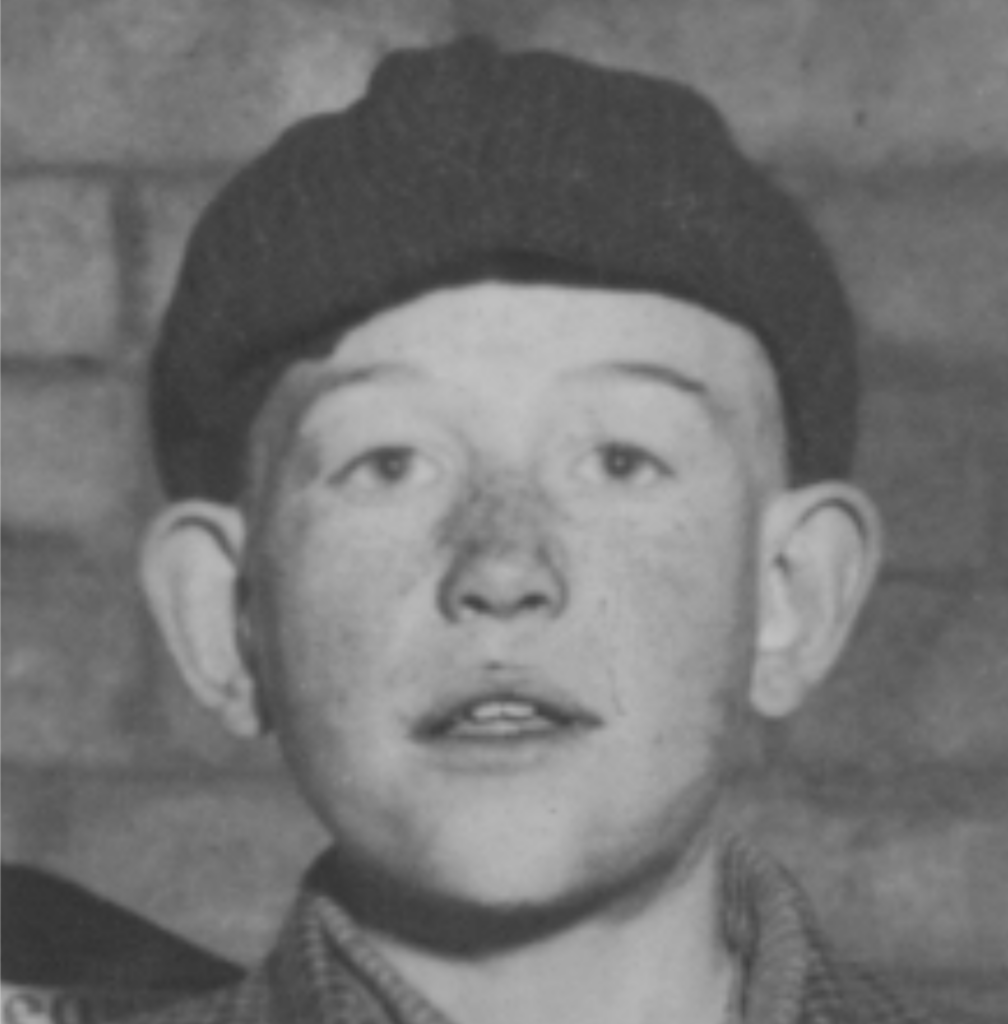
On August 9, 1908, it was reported that William Towle, “aged 15 years” (he was 14) and living at 44 Sheridan Avenue, “was struck by a southbound United Traction Delaware avenue car yesterday afternoon on Broadway in front of Public Bath No. 1, but escaped with a few slight bruises. He was taken to the Homeopathic Hospital by Inspector McCabe of the United Traction company. The doctor said that Towle was more scared than hurt. He was told to go home. Instead of following the advice of the doctor, Towle went with Morris Foreman, Myer Michaelson and Jacob Epstein to the Day line dock where, according to the police, they engaged in smashing baggage in violation of the city ordinances.”
Less than two weeks later, the Times-Union wrote that a “William Towle and John Simpson, more youthful baggage smashers about the Day line dock, on whom the police are waging a crusade, were arrested last night [August 21]. They were allowed to go.” The Argus wrote on Aug. 22 that the boys had been arrested before on a similar charge and were “taken to the Humane society last evening to await examination in Police Court this morning on the charge of loitering about the dock of the Day Line steamers, in violation of the city ordinances.”
In 1909, when he was reported as 13 years old (he was about 15), William Towle was picked up by the police at 11:30 p.m. on North Pearl Street for selling papers after hours, a violation of city ordinance. It wasn’t the first time.
On May 27, 1913, the Times-Union reported that “For working the fake trick of having his hand bandaged and begging for assistance, William Towle was committed for twenty days.”
On June 30, 1916, the following classified ad appeared in the Albany Evening Journal:
“WILL anyone knowing the whereabouts of Roderick Towle, kindly communicate with his brother William Towle, in care of Bills Lunch, Lorain, Ohio?”
So at some point William had set off for Lorain, Ohio, but he was back in Albany when he filed his draft registration in 1917, reporting that he was born in January 1894 in New York City, was single and working as a porter for the Clinton Square Theatre Company. He lived then at 17 Monroe St., which was a two-story dwelling three doors in on the north side of Monroe just west of Chapel. He reported that his mother was dependent on him, and his draft card notes an “unnamed Brother also live at home.”
I was able to find William living in Cleveland in 1940, with an Ohioan wife named Mary, and children Edith, 17; John, 15; Joanne, 11; Thomas, 9. William was not working, and Mary, whose occupation was research assistance in the “foreign news digest” industry, reported being out of work for 70 weeks. He also reported his highest grade completed was seventh grade.
On his 1942 draft registration card, William Joseph Towle reported living at 1651 East 73rd St., Cleveland, Ohio. He gave his place of birth as New York City, on Jan. 12, 1894. He said he was self-employed. Interestingly, the card gives his height as 5’9″ and his weight as 159 lbs., and notes “left leg four inches shorter than right.” I’ve had no luck finding information on his death, but he was still alive when his mother, Mary, died at age 82 in 1956.
Roderick Towle (aka Lefty Pierce)
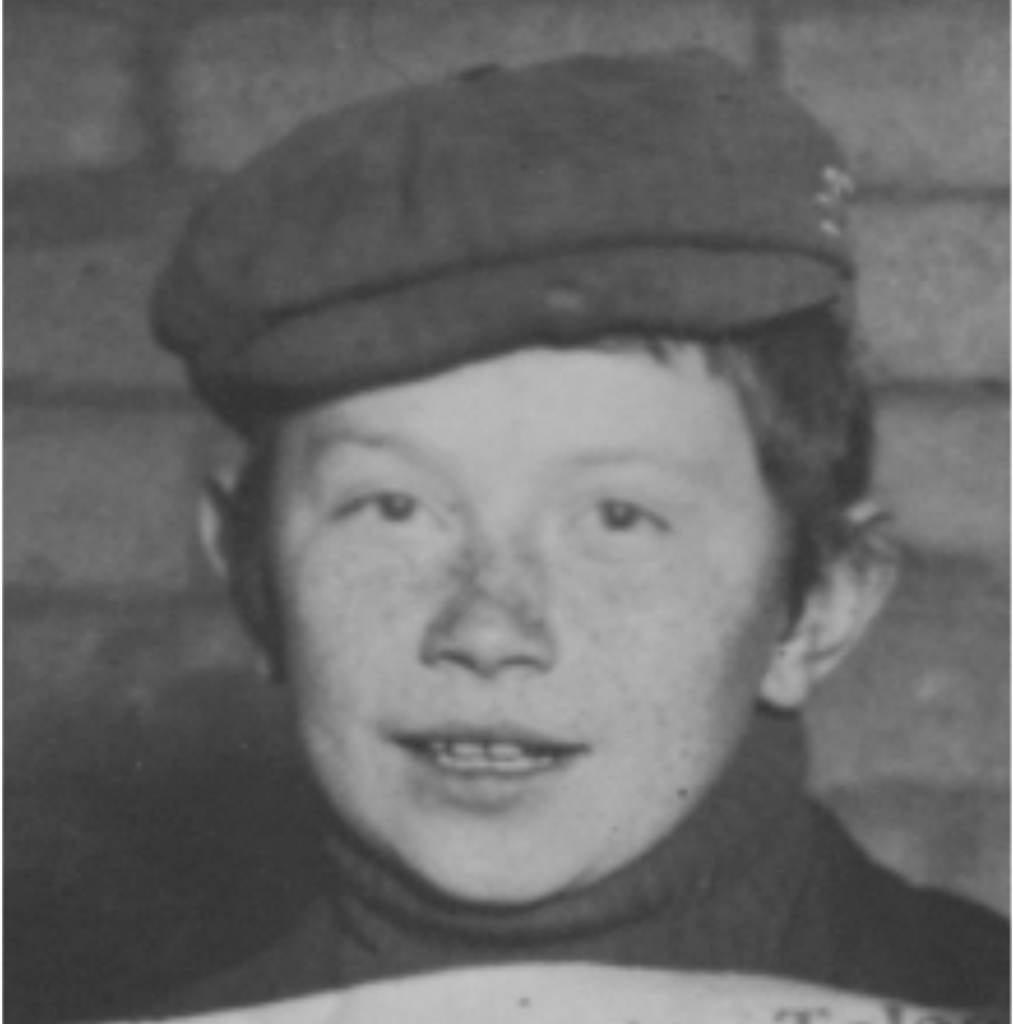
Roderick John Towle was born in August 1896. After the Hine photo from 1910, the first mention I can find is that he was working as a car cleaner for the New York Central Railroad when he registered for the draft in 1917. He entered the US Naval Reserves in May 1918, when he was living at 30 Chapel Street, and served as a seaman 2d class for 173 days. But around this same time he was making a name for himself as a boxer, and that name was “Lefty Pierce.” Active in the ring from about 1916-1922, here’s what the Knickerbocker Press had to say about him in 1917:
“Lefty Pierce, the Albany lightweight, who defeated Young Donahue of Mechanicville in German Hall the other night, looks like the most promising boy turned out by Albany in a long time. There isn’t a more willing youngster in the game than this same Pierce. He sure gives you a run for your money. Pierce, in the two bouts at the Albany club with Young Donahue, also showed he could take a punch on the jaw. Donahue hit him hard enough, it seemed, to send him to sleep but each time the youngster succeeded in shaking off the punch and coming back strong.”
Where young William mostly found his way into the newspapers through petty thievery, adult Roderick seems to have been in a lot of fights. And not just boxing matches. There was that time in December 1917 when he got shot in the leg during a Sunday morning “free for all” at the Garden Hall, formerly the German Hall, on Beaver Street. This hall was often a boxing venue, but this was no match. He refused to tell police who he thought shot him. Police had someone in mind, but Lefty wouldn’t snitch.
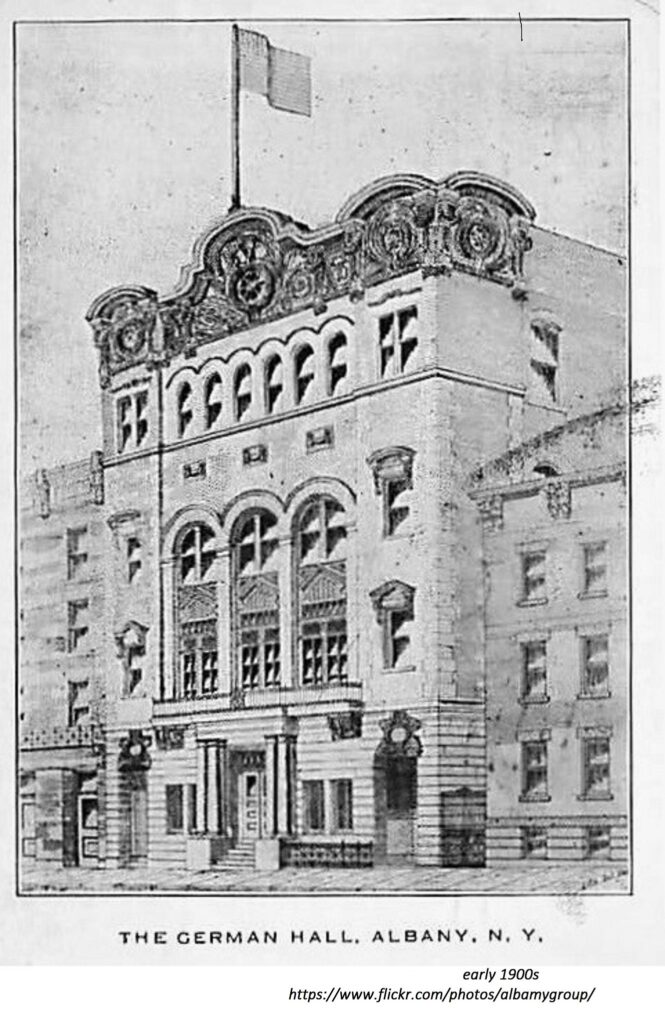
German Hall on Beaver Street, just west of South Pearl, hosted boxing events, and was later known as Garden Hall.
In 1919, Roderick was one of a group of men – but the only one named in an Argus article – accused of stealing and wrecking an automobile.
There was that time in 1923 when he was charged with trying to steal an automobile owned by the Waterford chief of police while it was parked in Albany. The car had been moved from North Pearl near Orange and was found nearby at the corner of Montgomery and Broadway. Roderick said, “The automobile started to move, when the brakes became loose, and I jumped on the running board and steered it, fearing that someone would be struck. The car stopped at Montgomery street and Broadway and I went away. I took a chance and probably saved the lives of some pedestrians. Now you men can arrest me if you want to but I will not answer any more questions.”
He had a few quiet years, at least in the newspapers, and then in 1926, living at 44 Orange Street, he was involved in an incident when a truck he was driving pinned a 45-year-old city employee against a pole and broke his leg on Odell Street. In 1927, he was charged with hitting another car.
In 1927 the Albany Evening News reported that the 30-year-old, identified as a former boxer who went by “Lefty Pierce,” got into a fight with another man in a soft drink parlor at 21 Division Street. Police broke it up and were taking him away when he escaped, but they found him and arrested him again. “Arthur Davis, taxi driver, was on hand to tell the court that Towle kicked him during the fracas.”
In 1928, “Lefty” got his skull cracked with a crowbar in a street fight with another boxer, Red Mack (George McElveney), at Monroe Street and Sheridan Place. Towle lived at 80 Sheridan Avenue in those days. “Police said there has been a long standing grudge between the two former fighters dating back for several years.” Towle slashed Mack with a razor before taking a crowbar to the head. “The fight started in a soft drink place run by Neil Caton, 59 Monroe street, where it is claimed Lefty started to bully a third man much smaller in stature and without Lefty’s pugilistic background. Red took up the side of the weaker and the fighters started at it. Both claim the other used a razor and Lefty says one of Mack’s pals introduced a crowbar into the discussion.” (Colorful description courtesy of the Amsterdam Evening Recorder.)
By 1930 Roderick had found a wife, Edith, and with her and two daughters was living on Sheridan Place, and working as a chauffeur for the city of Albany. In 1940, they had moved to 300 Second Ave., and his mother Mary (who then reported her birthplace was Ireland, but her obituary recorded it as Boston), was living with them.
That didn’t necessarily calm him down – In 1933, he was one of six men charged with beating up a taxi driver. In 1934, he was one of three men held in an assault on a man outside the State Grill, at Madison and Dove. In both instances, he was also identified by his former boxing name.
When he died in 1967 of a heart attack in Krank Park off First Avenue, the Times-Union remembered him as a boxer from the 1920s who boxed “with Red Mack and Billy DeFoe in the featherweight division.” He was, “according to a sports fan who remembered him, ‘a very tough guy’ in the ring. According to one fight fan, Towle fought Mack in 1926 [it was 1928] in a street brawl in Albany that sent both men to the hospital.” Never let it be said he didn’t do his civic duty, however – in 1926, Towle served as an election inspector.
Louis Strosberg
Of our five newsboys, Louis Strosberg seems to have had the fewest run-ins with the law in his youth. According to his WWII draft registration card, Louis Strosberg, one of three different spellings of his surname, was born Aug. 12, 1897, in Brooklyn, and thus would have been 12 in the Hine photo.
In the 1915 census, Louis Strasburg appears as the second son of Max and Annie Strasburg at 103 Herkimer St. . Max, then 42, and Annie, 38, had been in the US 24 and 22 years respectively, and were both naturalized. Louis was 18 in 1915 (so was born around 1897, in the US), and was a steamfitter’s apprentice. The other sons were Harry, 20; Jacob, 16; Bennie? 14; Joe, 13; and Irving, 6.
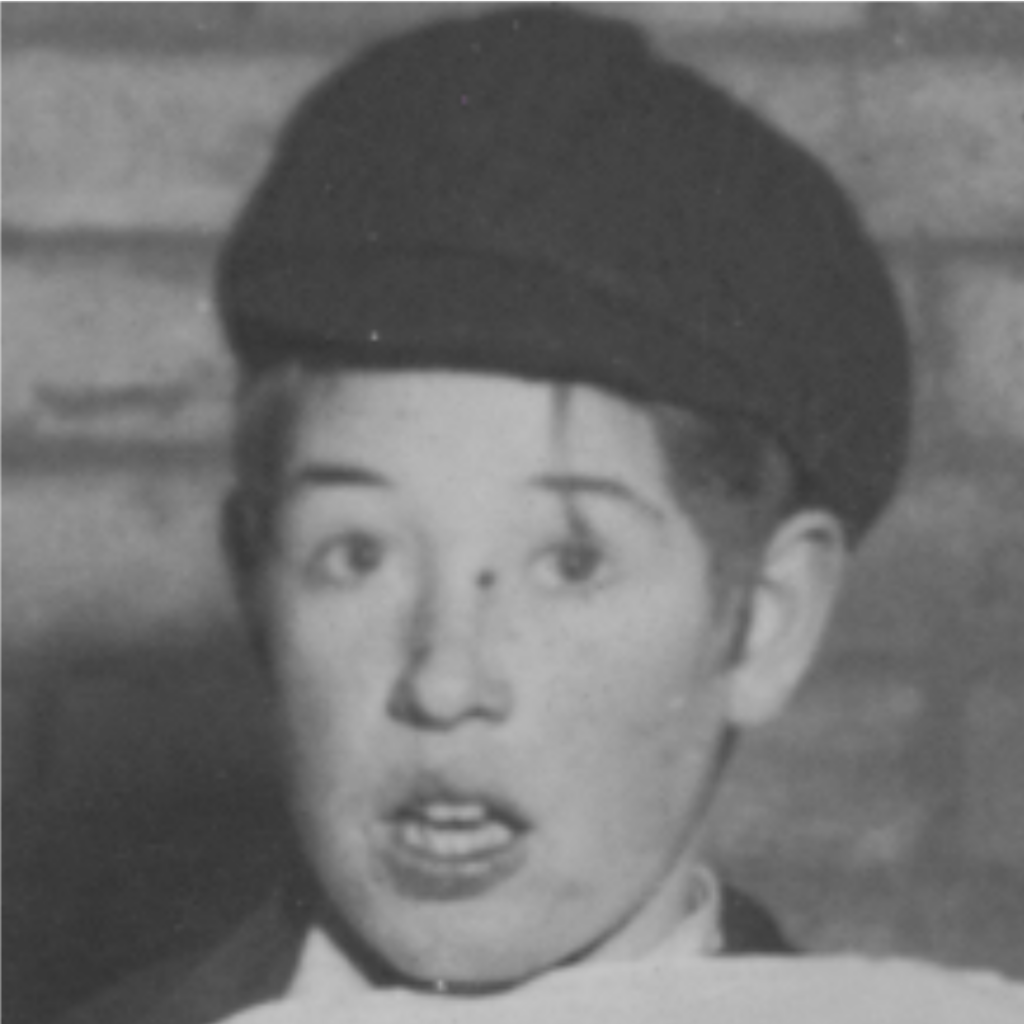
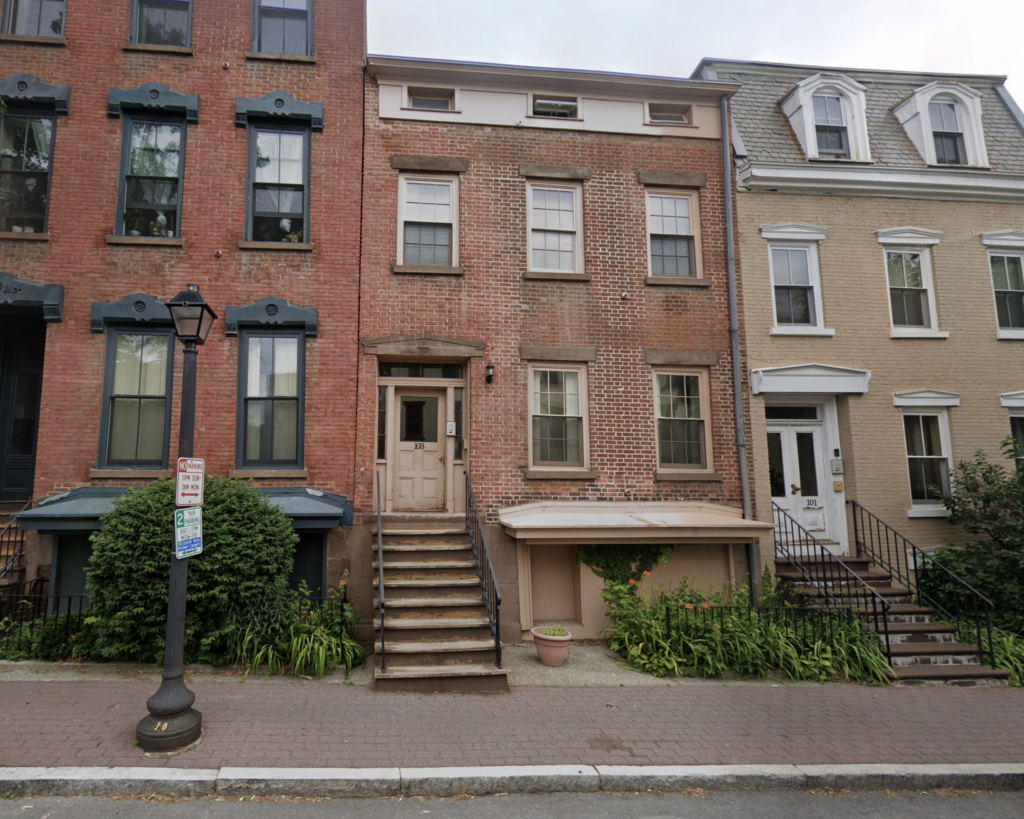
In the center, 103 Herkimer Street – in 1910, the home of the Strasburgs.
In 1907, he was on the Barry Juniors baseball team, as a left fielder. They challenged any team under 12 years of age. “All communications should be addressed to Joseph Lefkowitz, 34 Hamilton Street.”
In 1913, when he would have been about 16, he was one of four boys arrested at the Day line dock.
“Charged With Lounging. Benjamin Eison. Thomas Patterson, Louis Strasburg and Albert Dawson, a quartet of boys, who, according to the police, were loitering about the Day line dock at the foot of Hamilton street and annoying the passengers as they left the boat last evening, were taken into custody by Policemen Thull, Ryan and Reynolds. They were committed to the Humans society to await arraignment in Juvenile Court this morning on the charge of lounging.”
The Albany Argus, Saturday, 7/5/1913.
Louis appears to have mostly avoided trouble and the newspapers after that, with minor exceptions: In 1924, Louis Strosburg was named publicity chairman of the new Herzliah club, “named for Herzel, a Zionist leader. Its aim is to promote knowledge of the Hebrew language and literature.” In 1925, his taxicab was involved in a collision with another car that was mentioned in the Knickerbocker Press. He was living at 13 Ashgrove Place at the time; the rest of his family seems to have been living at 15 Ashgrove, home of father Max, who, in partnership with brother Jacob, had a coat making operation at 396 Broadway and a grocery at 103 Herkimer.
In 1940, I found Louis living at 438 Livingston Avenue with his wife Esther, from Austria, and 18-year-old son Sidney. Louis owned his own taxi, he reported. In 1941, he reported he worked for the Post Office. It appears that Louis lived until Feb. 22, 1974. Esther died in 1967, and Sidney died in 1980; they are all buried together in the Albany Hebrew Tailors Cemetery.
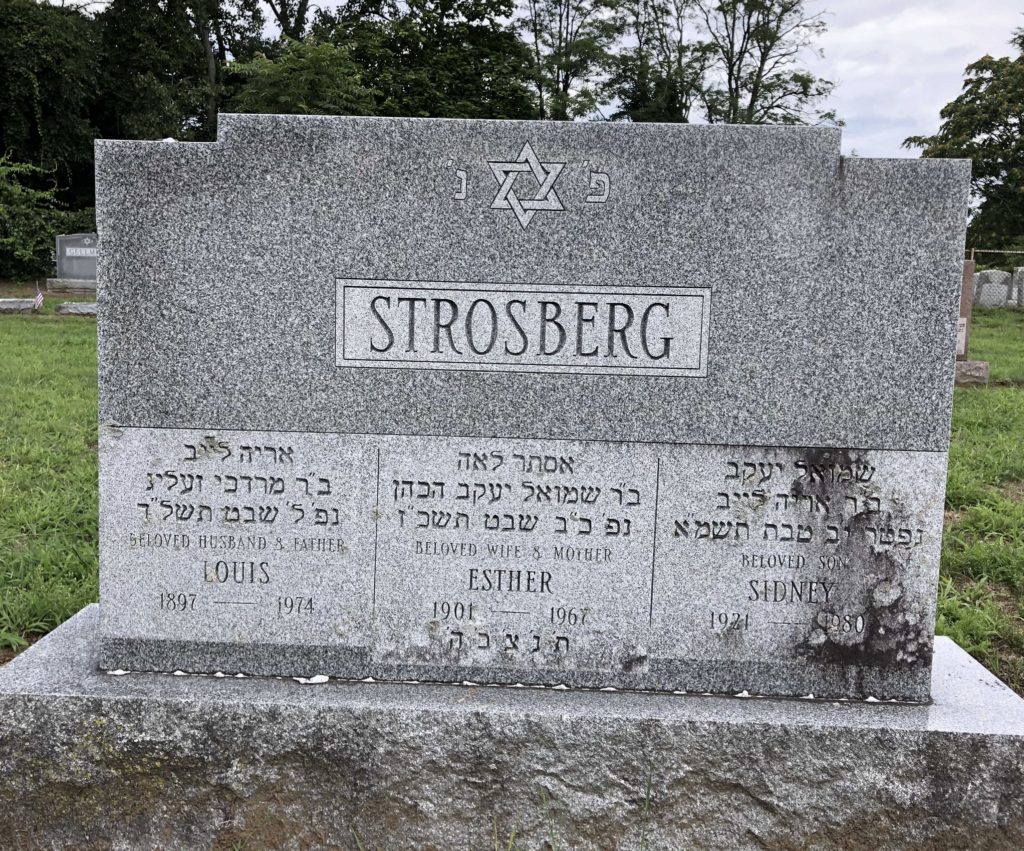
(Picture posted on Ancestry.com by Carolyn Merkel.)
Max Erlich

Max Erlich was born July 4, 1897, or July 1, 1899, in Litzha, Poland, and came to the US in 1905 – he reported both dates at various times. That means he was either 10 or 12 when this photo was taken. Father Isaac was a tailor, 39, married 14 years to Sarah, age 30, who had had six children, five of which were living. Those were Samuel, Max, Anna, Jacob and James. On the 1910 census, when the family was living on Dallius Street, everyone’s birthplace was given as “Russian Hebrew,” which is not a place. (Unfortunately, I also cannot say where Litzha was – it was likely part of the Russian partition of Poland – a search on Google maps today renders a place called Litovysche in Ukraine. And like the other boys, his age is reported variously and unreliably.
In February 1909, a year before this picture was taken, Max Erlich was one of several newsboys arrested “for peddling newspapers in the street without a badge, in violation of law.” Judge Brady “gave the boys a short lecture and after warning them that if they were again brought to court they would be punished, allowed them to go.” The other boys were Canon Travison, Peter Reubinstein, Dominick Nardillo [sic], Philip Feltman, Joseph Senz, Harry Simpson, Bennie Ellison, Herbert Tucket and Joseph Torsoni.
In June 1911, he was one of the boys arrested with Dominic Nardolillo for shooting craps, and was committed to the Humane Society for care.
Max was featured in the news on Nov. 8, 1912, under the headline “Boys Cannot Hang Around Pool Rooms.” Erlich, 14, living at 230 Hudson Avenue, claimed that he lost $3 in Dominick Gambol’s pool room.
“Judge Brady is determined to put a stop to the harboring of boys in local pool rooms, and yesterday, by his instruction, Assistant Superintendent Keating, of the Humane society, made a tour of the many pool rooms and warned the owners or managers of the resorts that it would be at their peril if boys under age were allowed to loiter there. Dominick Gambol, arrested a few days ago for allowing Max Erlich, a boy, to frequent his place, pleaded guilty to violating subdivision 1, section 1, of the penal law when arraigned in Police Court yesterday afternoon. On his plea of guilty Judge Brady fined Gambol $20, which was paid. Erlich, it is alleged, lost some money at gambling in Gambol’s place and was arrested by Policeman Waldbillig for committing a breach of the peace when he was outside of Gambol’s pool room, threatening to throw a brick through the window unless his money was refunded.”
He popped back up in December 1914 as “one of the most troublesome youngsters that the police have to contend with” when he was arraigned on a charge of idling about Union Station.
Somewhere around 1916, Max Erlich appears to have taken up boxing at German Hall, under the name “Young Davis.” It appears that “Young” was an appellation applied to any number of fighters who appeared in preliminary bouts. He may only have boxed for a couple of years, for in 1918, when he was arrested for a holdup, the newspaper said he “at one time aspired to be a prize fighter.” In addition to the holdup of a female stenographer, he was suspected of purse snatching. I did not find the disposition of this case.
In Sept. 1918, on his draft registration card, he gave a birthdate of July 1, 1899 and gave his age as 19 – which seems to shave a year or two from his age compared to other sources, including his 1942 registration. In 1918, he was living at 58 High Street, and working as a laborer at Rathbone, Sard on North Ferry Street.
He then disappeared from view – at least from a modern search perspective – for a long time.
In 1930, Max, 32, was reported in the census as married to Sophie, 27, who had come from Germany, and they were living at a home they owned at 45 Hollywood Avenue worth $15,500. He was proprietor of a cigar store. The census reported him and his parents as from “Russia (Pol)”, and that he had been naturalized in 1903.
In 1938, a Max Erlich, no age given, was charged along with Frances Edwards with possession of 286 grains of heroin, and pleaded not guilty, posting $1000 bail. That’s just a year before one of the Dominic Nardolillos was hit with the same charge.
In December 1944, Max was one of six men who pled guilty to charges arising from gambling raids. “Max Erlich, 46, arrested Oct. 18 at a newsstand at 64-1/2 Hudson, paid $200 for alleged possession of clearing house slips.”
Max Erlich died Jan. 28, 1954. A “Mrs. Erlich” survived him, who may have been his mother or may have been Sophie, as did sister Anna Freedman, and brothers Jacob, James, and Benjamin. Samuel had already died. No children were mentioned. According to the Troy Record, which got his age wrong, he was born in Russia, was a waiter by trade at the time of his death, and a member of the Independent Benevolent Society, a Jewish social mutual aid group, and his interment would be in the Independent Benevolent Society Cemetery, Guilderland.
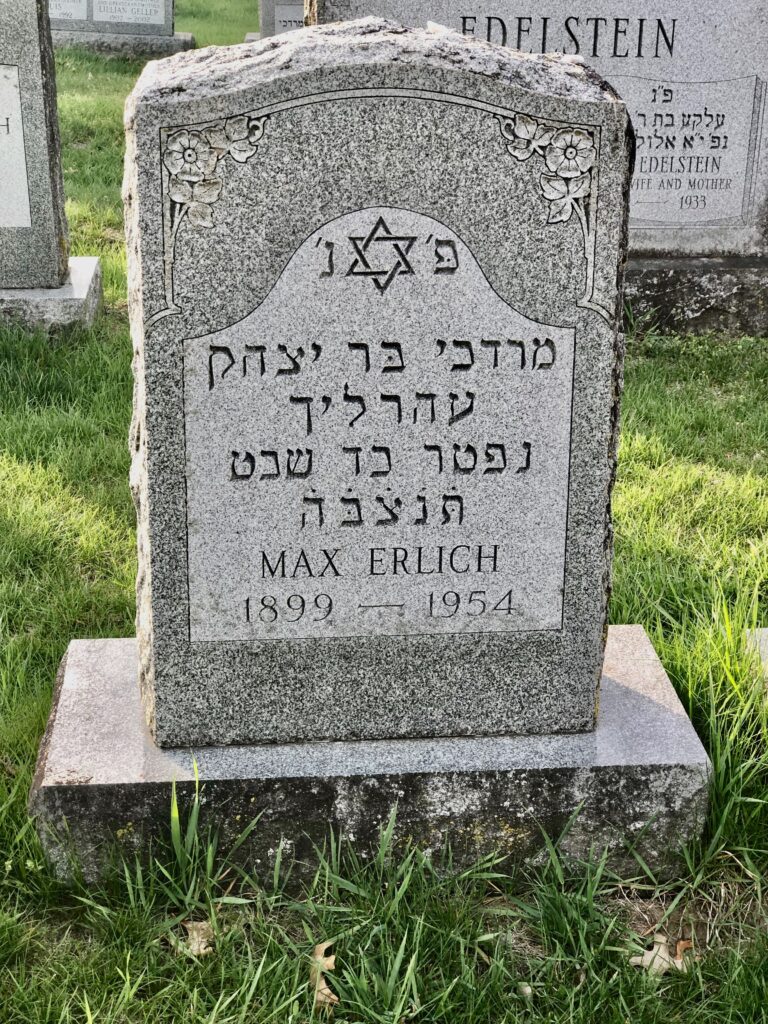
Now that we’ve talked about who they are, let’s talk about where they are: if they were behind the Albany City Jail, they were probably on Howard Street. The jail building was then a century old, having been built by Philip Hooker in 1810. Hine also captured the same boys playing craps in the alley at 10 PM.
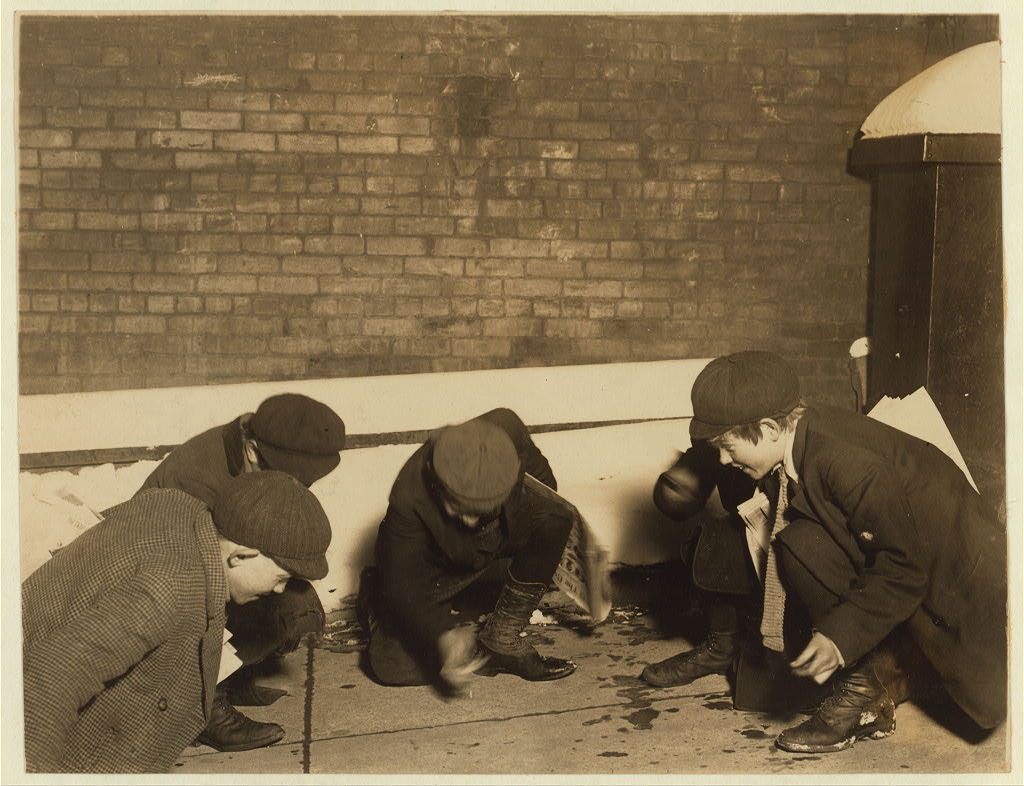
The boys are shown holding four different daily newspapers – the Albany Times-Union, and, from New York City, the Evening Journal the Evening Sun and the Evening Telegram. When I first wrote about this, I confused the Hearst Evening Journal with Albany’s paper of the same name, but the headlines here are about New York City Mayor William Jay Gaynor, and a sensational murder trial that was also taking place in NYC. There was also another blizzard expected to hit the city, following on a record-setting storm in January. A London newspaper reported that NYC’s “train service is demoralized.”
Lincoln’s image is prominent on the Journal and the Times-Union because it was his birthday, which was then celebrated on his actual birthday, February 12. Congress hadn’t yet merged Lincoln’s and Washington’s birthdays into a single day of weak remembrance.
Vying with Lincoln for attention was the sensational murder trial (at the time, pretty much all murder trials were sensational) of Maurice Lustig, who would be found guilty that May of slipping strychnine (then available at all the finer pharmacies) to his wife. Bigamy, confused alibis, insurance money, sham postcards sent out while his wife lay dying – this one had it all. Sentenced to death, Lustig received a new trial after two years in Sing Sing, but what happened then is too far outside of this picture.
The Times-Union then was at a fairly new location at the corner of Beaver and Green Streets, having outgrown its former storefront beginnings at Munsell’s printing operation on Broadway; it would move again to Sheridan Avenue in 1950 before leaving the city entirely in 1970, while continuing to decry its decline.
Albany probably had at least seven daily newspapers then. If there’s an afternoon newspaper alive anywhere today, I’m unaware of it; Albany’s last, the Knickerbocker News-Union Star, died in 1988. Officially, it merged into the Times-Union, which had long since switched to morning production.
Lewis Wickes Hine
If you’d like to know more about the work of Lewis Wickes Hine and the campaign against child labor, take a look at this article from The Smithsonian.

Leave a Reply